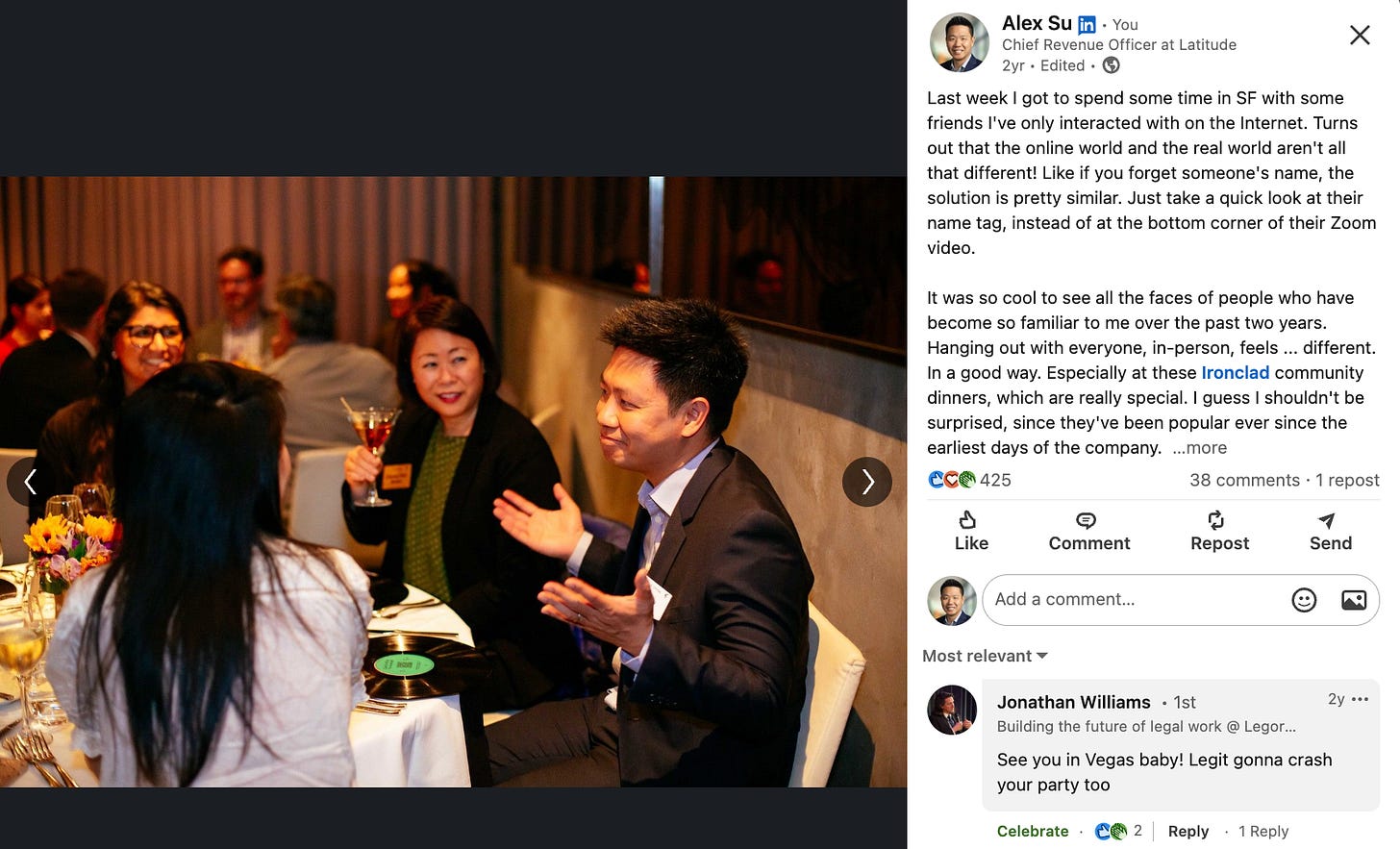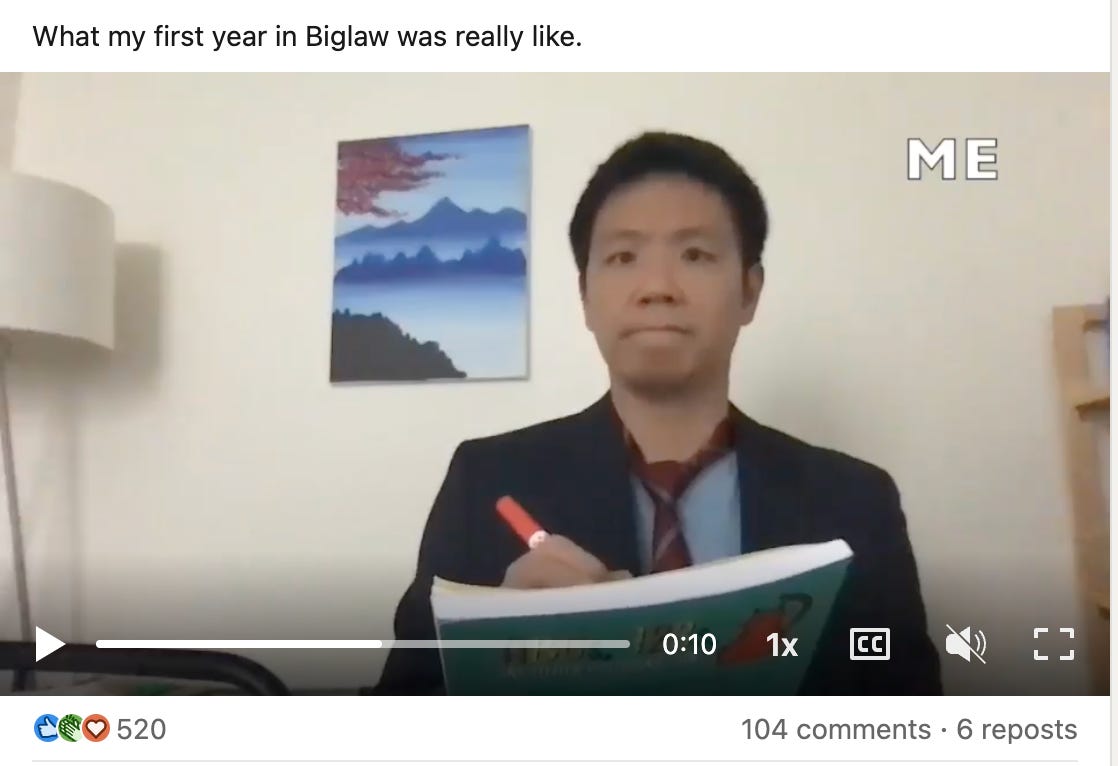Understanding demand
How my experience on social media and legal tech sales helped me figure out how to develop the "skill of demand"
It’s not often you read something that articulates what you have been feeling and experiencing for a long time, but haven’t quite been able to put into words. I got that feeling last night when I read Cedric Chin’s essay Speedrunning The Skill of Demand. What jumped out most to me is how Cedric succinctly describes everything that’s wrong with much of the sales/marketing tactics used in the legal industry.
Before I get into why, let me first explain what the essay is about. Cedric’s main point is something like this:
Businesses often incorrectly position their product/service from their own perspective. Instead, they must frame it in terms of their buyers’ wants & needs.
How does this play out in the legal industry? The simplest example is from your classic Biglaw partner who pitches clients by talking about the firm’s resume and credentials. Over the years I’ve heard countless corporate clients complain about these kinds of pitches. The main complaint is that the pitch fails to address what the client actually needs.1
It’s not just Biglaw partners who make this mistake by the way. Legal providers like AI startups, recruiters, services companies, all do the same thing
“Made by lawyers, for lawyers”
Backed by [insert name-brand venture capital fund]
Founded/led by [name] who formerly practiced at [name brand firm]
Now these pitches are not necessarily entirely ineffective. As I’ve written about before, credentials are an extremely useful proxy for quality in the legal world, where outcomes are difficult to judge. However, they are only valuable signals to the extent they cannot be replicated by competitors. Wachtell and Cravath can differentiate based on credentials, the other 198 firms in the AmLaw 200 need something more.
So what exactly is that something more? I’ll share three general strategies below, and use my experience in the legal tech space to illustrate the principles.
Basic: What does my target audience care about?
When I first got into CLM (contract lifecycle management) sales, I quickly realized that my company—Evisort—talked about our offering in a vacuum. All of our marketing material discussed our software’s features but failed to connect it to some key aspect of our buyers’ needs. To borrow Cedric’s terminology, we weren’t sufficiently attuned to demand.
Instead, sales were done in an ad-hoc way based on our founders & early employees’ personal relationships. We led off heavily with Evisort’s credentials (using a variety of the example value props described in the earlier section). Often, that was enough, since we didn’t need a ton of sales in the early days.
But as we scaled, we quickly realized that our marketing message wasn’t landing. There were more and more CLMs coming to market, and many of them used similar language as us. In such a crowded market, how could we find a way to break through the noise?
I ended up stumbling into a solution in a completely unexpected way. This was mid-2020, during the early days of the pandemic, and I was starting to try posting different types of content on social media. I posted a joke video skit making fun of first year associates at Biglaw firms. I thought our target market of in-house lawyers might find it amusing, but probably irrelevant to what Evisort offered.
Instead it was the complete opposite. All the in-house lawyers found it relatable. Many senior decision makers at in-house legal departments were themselves former first year associates. Even those who never worked in Biglaw could laugh about it because they dealt with them as outside counsel.
Eventually, some of these in-house lawyers started reaching out to me for sales conversations about Evisort’s CLM.
This experience made me realize that by leading off with our offering, my company was missing out on a huge opportunity to be relevant to our target audience. Our buyers cared about contracts and CLM, but they also cared about a lot of other things, like exorbitant fees charged by Biglaw firms, or the unique nature of Biglaw recruiting & training.
By talking about something that our audience cared about that was less connected to what we were selling—I was able to cut through the noise and generate sales leads. As Cedric wrote in his essay, “You need to pick a topic that is interesting to your target customer.”
Intermediate: Where else can I find them?
A few years later, after I’d developed a niche following through my social media content, I found myself at a crossroads. I had spent the previous two years getting dialed in on content marketing on LinkedIn for in house lawyers. The problem was that I was starting to see diminishing returns. The word was out and it seemed like every legal tech startup was leveraging LinkedIn/short form video now.
This was around 2022, around the time that things started opening up in the real world post-pandemic. I remember that was the year I started attending live events again, like meetups and conferences. By then I was working at my second CLM company, and had shifted my role from generalist, to more of a specialized marketing role.
What I found “in the real world” was that my key audience of in-house professionals on LinkedIn was somewhat saturated. Most of the people who were online were likely familiar with my Tik Toks and memes. However, there was an equally large audience of in-house lawyers who were not active online, who had never heard of me.
It dawned upon me that this was a critical segment I needed to start getting in front of more. I already understood the profile; they were virtually identical to the typical in-house professional on LinkedIn—they just didn’t spend that much time online. So I didn’t have to do a ton of additional research to make myself relevant to this audience. I just needed to get out there and meet them in the real world.
It was around this time I decided to make a pivotal change to how I approached social media. It became obvious to me that even if I dedicated myself to growing my online audience even more—it would likely produce minimal business ROI. Meanwhile, huge swaths of the in-house community remained unaware of me, my company, and our offerings.

Cedric’s point about the difference between being an effective content marketer vs. effective marketer in general hits home here:
Next, you figure out how to reach customers with those properties. If you are a content marketer, this will look like asking: “now that I know my target audience (i.e. folks with similar properties to our best customers) what do they read?” And then: “let’s plot a content schedule around that.”
. . . Hmm, interesting. Maybe these folks don’t read. Never mind. Where else can I find them?” This might be specific conferences, or ads in airport terminals, or LinkedIn cold outreach, or specific types of podcasts. You can then spin up tightly scoped initiatives — with small budgets! — for those channels.
Advanced: What segments of the audience are best for us?
This final piece will be highly anecdotal and a bit complicated. I’m still trying to figure out how to articulate it—in fact, it’s a growth area for me. The goal though, is fairly simple: How do you specifically target potential buyers with the highest likelihood of being valuable to your company long-term?
I’ll share a story from my Evisort days that helps illustrate the concept. Some background first: Evisort’s product strengths (at least in 2020-21) were in post-signature contract management. We were not good at pre-signature, ie. streamlining the approval/collaboration process of getting a new contract signed. Instead, we were strong in identifying what was in your executed contracts automatically (using our proprietary AI).
So when we marketed ourselves to buyers as a “CLM” we often pulled in two unique segments: (1) pre-signature prospects and (2) post-signature prospects. The second group had shorter sales cycles, larger average deal sizes, etc. It quickly became obvious that the second group was a much better target for us.
But how could we market to them effectively? By talking about our offering in the language most familiar to us we were obfuscating our true value. Telling in-house lawyers that we were a “end to end CLM” was counterproductive because it funneled buyers into evaluating us where we were weak. On the flip side, telling them that we were primarily a “post-signature CLM” was confusing because it was vendor-centric language that was unfamiliar to the buyer.
I’m not sure we ever came up with a complete solution to this conundrum. However, in the months before my departure (to Ironclad, the second CLM company I worked for) I started to see some opportunity. For example, instead of using “post signature” language in our marketing, we could say something like “are you tired of missing auto-renewing contracts?”
Missing auto-renewals was a huge problem for our target audience. These were understaffed legal teams that were increasingly relying on software subscriptions that they’d planned to cancel but instead accidentally let lapse. Because they had auto-renewal clauses, the buyers’ company would be on the hook for 5 to 6 figure annual contracts they didn’t need. Legal would often get blamed.
I didn’t realize how potent this messaging was until we sort of stumbled into it. One of our paid ads led to an unusually large deal that closed unusually quickly. It just so happened that the buyer was one of my customers, so I took some time to better understand how they found us and why they moved forward quickly.
And it ended up being the exact fact pattern above. The company had accidentally auto-renewed on a massive subscription contract, which led to the CFO greenlighting a huge budget for CLM.
A few months later I ended up leaving Evisort so I don’t know if they ever fully leveraged this learning. The marketing team was stretched thin, and was being asked to do a million things by the executive leadership team. I’m not sure if they ever had a chance to dig in deep into stories, anecdotes, and data.
Conclusion
All of this stuff is hard! Sales and marketing can be complicated and often involves so many details, data points, and incomplete data. However, you can overcome a ton of challenges if you just focus on the demand side of the equation—instead of focusing on your offering.
For anyone who’s interested in generating more revenue or business for themselves or their organization, I highly recommend checking out Cedric’s essay. I’m also a big fan of his other work around career moats and business.
Cedric makes a similar point in talking about content marketing; “A good content writer may think about things like craft and topic selection and sentence structure. A good marketer thinks about the customer. And the key thing to internalise is that the customer does not care about your writing, or about your product.”


